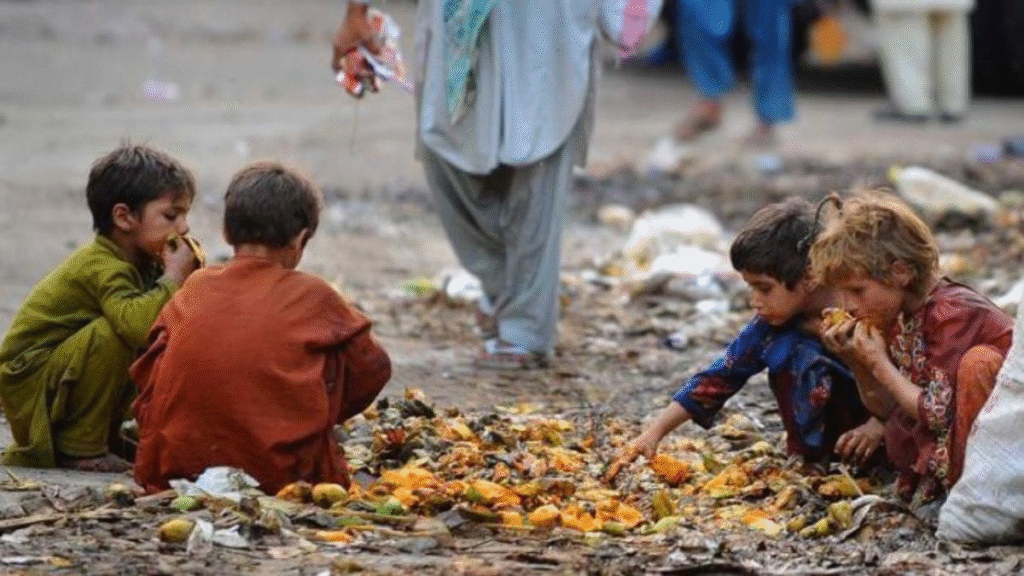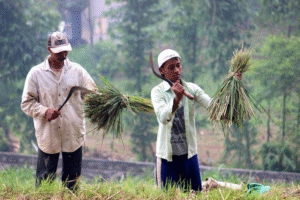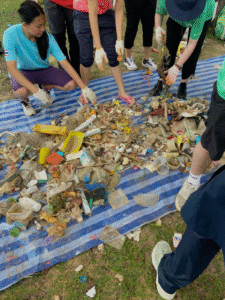By Akshika Jangid
Food security is ensured when there is a sufficient requirement of food available for everyone, everyone has the means to purchase the food of an acceptable quality and has equal access to it. So, addressing rising food prices becomes a crucial issue for protecting the poor, especially in India, where households spend 45% of their income on food. Since many low-income families depend on government-subsidised grains for their basic nutrient needs, bridging the gap between food abundance and accessibility becomes utmost important.
Presently, India ranks at 105 out of the 127 countries on the Global Hunger Index and as per the Global Food Security Index 2022, with a GHI score of 27.3 highlighting a serious hunger crisis. Despite the government actively taking steps in addressing food security through Public Distribution System (PDS) and National Food Security Act, 2013, there are still gaps within these programmes that prevent its effective implementation amidst the factors like increasing population, climate change and Geopolitical issues such as Russia-Ukraine war. According to the Food and Agriculture Organization (FAO), while global food prices were 7.6% higher year-on-year as of July 2025, India’s domestic food inflation has eased significantly, with food prices falling by 1.76% year-on-year in July 2025, the lowest level since 2019.
According to the World Bank Group report titled, “Schemes to Systems | the Public Distribution System: Anatomy of India’s Food Subsidy Reforms”, the programs like PDS being the largest food subsidy program providing subsidised staples to over 800 million people has failed to mitigate losses from food price shocks. There are some persistent vulnerabilities and challenges which prevent the programme from progressing such as nutritional deficiencies, unequal distribution, erratic rainfall, extreme weather and post-harvest loss and inefficiency adversely affect household and individual level food insecurities. Despite the increase in per capita dietary energy supply since the early 1990s, undernourishment and malnutrition still remain rampant.
Following the implementation of NFSA in 2013, 74% of the the rural population and 50% of the urban population come under Antyodaya Anna Yojana (comprises of poorest of poor to receive 35 kg of grains per household per month) and Priority Households category (covers households entitled to 5 kg per person per month). The act also entails special provisions for children aged between 6-14 years which provides them nutritious meals through the large scale network of Integrated Children development services (ICDS) centres/ Anganwadi Centres. The act follows a ‘Lifecycle approach’ as it pays attention to Pregnant women/Lactating mothers who are entitled to receive a cash maternity benefit to compensate for the wage loss during their pregnancy period. The act guarantees that the eldest woman in the household, aged 18 years or above, can be designated as the head of the household for the purpose of issuing ration cards and availing benefits.
While the role of PDS and NFSA have played an important role in improving food security through provision of calories intake, there are still issues regarding mis-targeting, under-coverage, corruption, lack of infrastructure, operational inefficiencies and diversion affecting the overall operation of the food network of India.
Identifying the gaps with food security programmes:
Despite significant reforms, corruption and losses persist in the Public Distribution System (PDS) especially at the level of fair price shop owners as they often substitute high-quality government goods with lower-quality products. Targeting errors, particularly in identifying Below Poverty Line (BPL) and Above Poverty Line (APL) households, hinder the act’s effectiveness. While efforts have been made to target BPL households, these efforts have had limited impact on the poor. Additionally, non-poor households have been included in the PDS, negatively affecting the system (George and McKay, 2019).
Real life examples of steps taken to address these gaps:
States like Chhattisgarh, Madhya Pradesh, Jharkhand, Bihar, Odisha and West Bengal are among the poorest states that have performed quite well in terms of coverage, targeting and implementation of NFSA. Chhattisgarh being the pioneer to implement the act in December 2012, has a well-functioning and universal PDS reforms that guarantees 7Kgs of basic foodgrains (More than the NFSA’s 5kgs norm) per month to rural households along with some pulses and fortified salts. These Targeted Public Distribution reforms have had a positive impact on the design and implementation of the programme as some of the leakages have been prevented due to digitisation efforts which involves end-to-end computerization, Aadhaar seeding of ration cards, and the use of electronic Know Your Customer (eKYC). Additionally, the recent execution of the One Nation One Ration Card (ONORC) has enabled the portability of Ration Cards that has further empowered India’s migrant population by providing them access to their entitled foodgrains anywhere in the country.
Given the complexity of the programme, the government developed an Index in order to evaluate the implementation of the NFSA and TPDS across states and union territories. This Index promotes competition, cooperation, and learning among states, ensures transparency, and provides reliable data for research and analysis. It is based on three key pillars: coverage and proper targeting under NFSA, efficient foodgrain delivery systems, and initiatives to improve nutrition. Each pillar includes detailed parameters for assessment.
The findings from the report titled “State Ranking Index for NFSA, Creating resilient food systems to optimize the delivery of benefits” by the Microsave Consulting show that most states and union territories have done well in digitization, linking Aadhaar, and installing e-PoS (Electronic Point of Sale System) devices, reflecting the success of reforms. However, areas like conducting proper social audits and activating state food commissions need improvement to strengthen the Act’s implementation.
Odisha, Uttar Pradesh, and Andhra Pradesh ranked highest overall, excelling in all areas of NFSA implementation. Among special category states (Northeast, Himalayan, and Island regions), Tripura, Himachal Pradesh, and Sikkim performed exceptionally well, overcoming logistical challenges. Andhra Pradesh, and Telangana led in efficient TPDS delivery systems, showcasing strong supply chain management. Thus, it’s only through transparency, better governance, technology, and doorstep delivery that can be the potential solutions to these persisting problems.
Measures to tackle food insecurity:
The national food security is critically dependent on the adequate availability of sufficient food stocks to satisfy domestic demand at all times which can be ensured either through domestic food production or imports. To truly tackle India’s food insecurity, policy interventions must focus on revamping the Mid-day meal programme for school children by diversifying food baskets beyond staples to include protein and micronutrient-rich options and ensuring efficient targeting through biometric verification and streamlined logistics.
Meanwhile, reducing food waste requires robust infrastructure investments in storage, transportation, and cold chain technologies. Empowering farmer collectives such as Farmers Producers organisations especially women collectives by providing them training and market access tools in order to minimise losses and connect them directly to consumers (Ray, Soumyajit; Raghunathan, Kalyani; Bhanjdeo, Arundhita; and Heckert, Jessica. 2024). Additionally, policies that focus on promoting sustainable agricultural practices like climate-resilient crops, crop diversification, soil health management and efficient distribution of certified quality seeds of millets and pulses are essential to build resilience against the growing threat of climate change. Apart from production, empowering women through education and land ownership will foster their participation in decision-making and improve household food security as it will ultimately prevent the misuse of names by other men in the households.
Thus, by implementing these multi-pronged policy interventions, India can shift from a fragile equilibrium of food production to a more equitable and sustainable food security system. This requires addressing not just the supply side, but also the distribution, accessibility, and resilience of its food systems.
Works Cited
Chapter 5 Reforms in Targeted Public Distribution System. (n.d.). Available at: https://cag.gov.in/uploads/download_audit_report/2016/Chapter_5_Reforms_in_Targeted_Public_Distribution_System.pdf
Drishti IAS. (2024). Global Hunger Index 2024. [online] Available at: https://www.drishtiias.com/daily-updates/daily-news-analysis/global-hunger-index-2024
Ideas For India. “Food Security Act: How are India?s poorest states faring?” Ideas For India, 2016, https://www.ideasforindia.in/topics/governance/food-security-act-how-are-indias-poorest-states-faring.html.
National Food Security Portal (2013). NFSA. [online] Nfsa.gov.in. Available at: https://nfsa.gov.in/portal/NFSA-Act.
OIDA International Journal of Sustainable Development, Ontario International Development Agency, Canada. “Food Security in India: Problems and Prospects.” no. ISSN 1923-6654 (print) ISSN 1923-6662 (online), pp. 11-12. http://www.ssrn.com/link/OIDA-Intl-Journal-Sustainable-Dev.html.
Ray, S., Raghunathan, K., Bhanjdeo, A. and Heckert, J. (2024). Can farmer collectives empower women and improve their welfare? Mixed methods evidence from India. [online] Cgiar.org. Available at: https://cgspace.cgiar.org/items/707e3db5-8134-43ce-bada-561ab3d23bdc
[Accessed 5 Jan. 2025].
State Ranking Index for NFSA Creating resilient food systems to optimize the delivery of benefits. (2022). Available at: https://www.microsave.net/wp-content/uploads/2022/08/NFSA_2022.pdf










